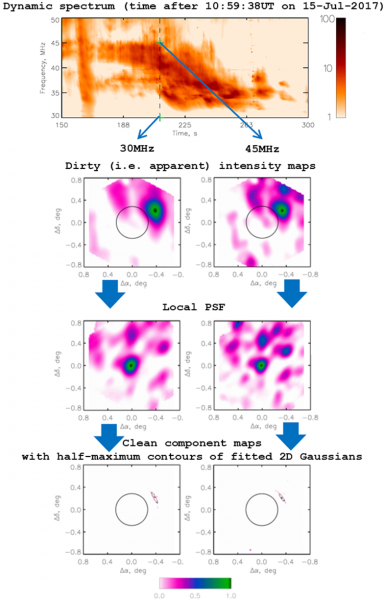The plasma density and magnetic field in the upper solar corona and inner heliosphere are not sufficient to produce detectable bremsstrahlung hard X-ray or gyrosynchrotron microwave emissions, making metric and decametric coherent radio emissions the only tool for probing energetic electrons in these layers of the solar atmosphere (e.g. McLean & Labrum 1985; Pick & Vilmer 2008 as reviews). This source of information is vital to understanding the underlying mechanisms of energetic electron transport in the corona, and their escape from the corona into the heliosphere. In this study, we develop a novel method to evaluate the effective PSF of a radio array using observations of a known source (i.e., a radio calibrator) at an arbitrary location. The method is then used to correct the intensity maps of solar radio bursts observed by the Low Frequency Array (LOFAR), and evaluate the sizes and shapes of sources.
In this study, we investigate solar radio bursts in the frequency range 30–45 MHz observed in 2015 and 2017. Spectral-imaging data for these events have been obtained using LOFAR in the tied-array beam mode. The considered solar radio bursts are of different types, ranging from short-duration events containing a single type III burst (e.g., 2017 July 13 event) to long-duration type II and IV storms (e.g., 2015 June 20 and 2017 July 12 events). Figure 1 demonstrates the method using a well-observed transitioning type II burst observed on the 15 July 2017 (Chrysaphi et al., 2020).

Figure 1: Solar radio map deconvolution procedure. Top panel shows the dynamic spectrum, the logarithm of intensity vs. time and frequency, for the considered event. Second row panels show dirty maps observed at 11:03:07 UT at 30 and 45 MHz. Third row panels show corresponding LOFAR PSFs derived using the combined PSF for the location of the Sun at the moment of observations. Bottom panels show corresponding clean component maps (color scales) and their 2D Gaussian fits (black and orange dashed lines show their half-maximum contours).
Conclusions
We have developed and tested a novel, simple method for deriving the Point Spread Function (PSF) of an instrument based on known nearly point-like source observations. In the 30–45 MHz range, the area of the effective PSF is about 1.6 times bigger than the nominal PSF area. Although out of nine considered events the smallest size corresponds to a type III burst (2017 July 13 event), while the largest (in terms of its average size) source corresponds to the type IV burst (2015 June 20 event), there is no systematic difference between type II and IV, and type III event. At the same time, the source sizes, their variation with frequency, and most importantly, ellipticities of the sources are consistent with the models of anisotropic radio-wave scattering in the corona and inner heliosphere (Kontar et al. 2019; Chen et al. 2020). Therefore, our findings support the concept that the sizes of low-frequency solar radio sources are determined primarily by radio-wave scattering in the upper corona, rather the physical sizes of the emitting regions.
Based on recent paper by Gordovskyy et al, Sizes and Shapes of Sources in Solar Metric Radio Bursts, The Astrophysical Journal, 925, id.140, DOI:10.3847/1538-4357/ac3bb7
References
Chen X., Kontar E. P., Chrysaphi N. et al. 2020 ApJ 905 43
Chrysaphi N., Reid H. A. S. and Kontar E. P. 2020 ApJ 893 115
Gordovskyy et al, 2022 ApJ 925 140
McLean D. J. and Labrum N. R. 1985 Solar Radiophysics: Studies of Emission from the Sun at Metre Wavelengths, New York: Cambridge Univ. Press
Kontar E. P., Chen X., Chrysaphi N. et al. 2019 ApJ 884 122
Pick M. and Vilmer N. 2008 A&ARv 16 1
